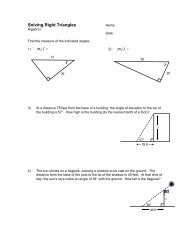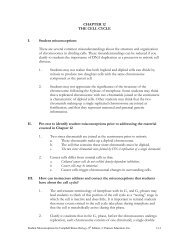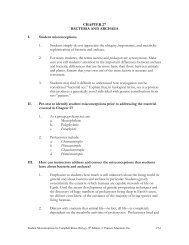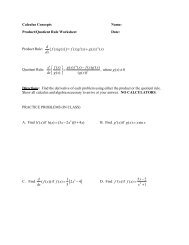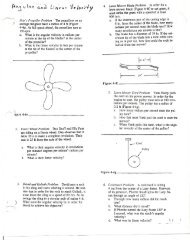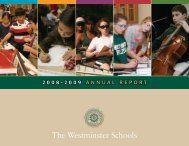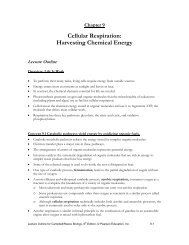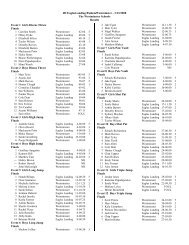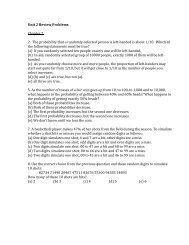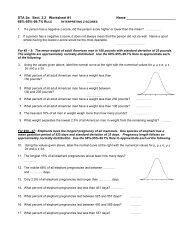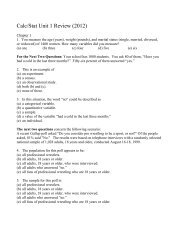CHAPTER 14 MENDEL AND THE GENE IDEA - Hancock High School
CHAPTER 14 MENDEL AND THE GENE IDEA - Hancock High School
CHAPTER 14 MENDEL AND THE GENE IDEA - Hancock High School
You also want an ePaper? Increase the reach of your titles
YUMPU automatically turns print PDFs into web optimized ePapers that Google loves.
o<br />
The probability of producing a ppyyRr offspring:<br />
• The probability of producing pp = 1/2 × 1/2 = 1/4.<br />
• The probability of producing yy = 1/2 × 1 = 1/2.<br />
• The probability of producing Rr = 1/2 × 1 = 1/2.<br />
• Therefore, the probability of all three being present (ppyyRr) in one offspring is 1/4 ×<br />
1/2 × 1/2 = 1/16.<br />
o For ppYyrr: 1/4 × 1/2 × 1/2 = 1/16.<br />
o For Ppyyrr: 1/2 × 1/2 × 1/2 = 1/8 or 2/16.<br />
o For PPyyrr: 1/4 × 1/2 × 1/2 = 1/16.<br />
o For ppyyrr: 1/4 × 1/2 × 1/2 = 1/16.<br />
o Therefore, the chance that a given offspring will have at least two recessive traits is 1/16 +<br />
1/16 + 2/16 + 1/16 + 1/16 = 6/16.<br />
Although we cannot predict with certainty the genotype or phenotype of any particular seed<br />
from the F 2 generation of a dihybrid cross, we can predict the probability that it will have a<br />
specific genotype or phenotype.<br />
Mendel’s experiments succeeded because he counted so many offspring, was able to discern the<br />
statistical nature of inheritance, and had a keen sense of the rules of chance.<br />
Mendel’s laws of independent assortment and segregation explain heritable variation in terms of<br />
alternative forms of genes that are passed along according to simple rules of probability.<br />
These laws apply not only to garden peas but to all diploid organisms that reproduce by sexual<br />
reproduction.<br />
Mendel’s studies of pea inheritance are a model not only in genetics but also as a case study of<br />
the power of scientific reasoning using the hypothetico-deductive approach.<br />
Concept <strong>14</strong>.3 Inheritance patterns are often more complex than predicted by simple<br />
Mendelian genetics.<br />
In the 20th century, geneticists extended Mendelian principles both to diverse organisms and to<br />
patterns of inheritance more complex than Mendel described.<br />
In fact, Mendel had the good fortune to choose a system that was relatively simple genetically.<br />
o Each character that Mendel studied is controlled by a single gene.<br />
o Each gene has only two alleles, one of which is completely dominant to the other.<br />
○ The heterozygous F 1 offspring of Mendel’s crosses always looked like one of the parental<br />
varieties because one allele was dominant to the other.<br />
The relationship between genotype and phenotype is rarely so simple.<br />
Extending Mendelian Genetics for a Single Gene<br />
The inheritance of characters determined by a single gene deviates from simple Mendelian<br />
patterns when alleles are not completely dominant or recessive, when a gene has more than two<br />
alleles, or when a gene produces multiple phenotypes.<br />
We will consider each of these situations.<br />
Lecture Outline for Campbell/Reece Biology, 8 th Edition, © Pearson Education, Inc. <strong>14</strong>-7




